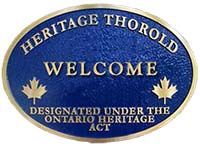DeCou House Monument c.1808
Cultural Value
John DeCou was involved in many aspects of our local history and development of the area. The DeCou stone house played a pivotal role in the War of 1812, the Battle of Beaverdams and Laura Secord’s famous walk.
Architectural Significance
This monument incorporates the remains of a Georgian style house built by Captain John DeCou early in the 19th century. The visible portion of the monument which was constructed in the early 1950’s, after the second of two fires had gutted the home, consists of a portion of the original limestone walls of the house rising to the level of the lower first floor window sills, a flagstone floor and a plaque mounted on a cairn constructed at the rear wall (unveiled Oct.13-53). Beneath the floor is the original basement of the home which was filled with the rubble from those portions of the walls of the house which had remained standing after the fire and which were taken down when the monument was constructed. This monument is unique in that it presents somewhat of the appearance of a ruin uncovered or exposed by an archaeological dig.
Historical Significance
The DeCou family were of French Huguenot origins (W.coast of France–Saintonge province). In 1798 John DeCou married Catherine Dochstader who was born at Fort Niagara in 1781, the daughter of a Loyalist who had lost his life while fighting in New York state with Col.John Butler’s Corps of Rangers during the Revolutionary War. John and Catharine had ten children. In 1804 DeCou was elected a director of the Niagara District Agricultural Society (first in Upper Canada); he was Township of Thorold Collector, Assessor and Township Warden and one of the founders of the Niagara Library.
John DeCou was Lieutenant of a company of militia in the 2nd Regiment of Lincoln, District of Niagara in 1809; General Brock became a regular visitor at DeCou’s home. The house was used as a store and garrison for British troops in the war of 1812. Ltnt. James FitzGibbon of the 49th regiment took up residence at the stone house along with a troop of volunteers. At one period while John DeCou was in prison, the house was occupied by soldiers while the Indian allies camped in the farm’s fields. The house remained a military outpost well into 1814. The house was ransacked twice by the Americans in 1813-14.
John DeCou’s grist mills employed many and a settlement called “DeCew Town” grew near them with a school, church and blacksmith shop. John DeCou became one of the incorporators of the Welland Canal Co. when it was formed in 1824. In 1833 after the destruction of his milling business, he purchased 600 acres of bush land on Derquania Creek in N. Cayuga where he constructed a dam across the creek and built two sawmills and a grist mill. A hamlet sprang up known as “DeCewsville”. He was active in political matters and died in 1855; he was buried at DeCewsville.
